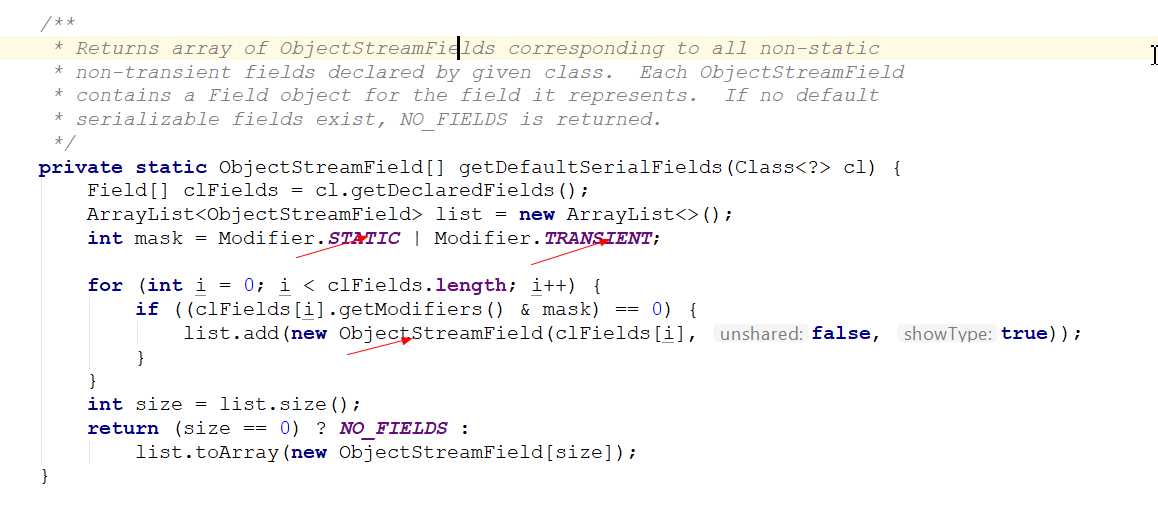java中的序列化和反序列化
2021-04-09 07:26
标签:hidden oid NPU aci 处理 int() ring checked lan 序列化就是将对象转换成字节序列,反序列化就是将字节序列转换成对象。 一个类要序列化必须实现Serializable接口,序列化字段为非static非transient修饰, 从结果可以看到反序列化出的对象是一个新的对象。 自定义序列化必须添加writeObject方法,必须为private非static,参数类型为ObjectOutputStream,返回类型为void。 writeReplace方法会在真正的序列化执行之前执行,会替换我们的待序列化对象,readResolve会在反序列化执行之后执行,就可以对结果做一些后置处理。通过readResolve我们可以进行单例的保护性恢复,直接返回单例实例。 java中的序列化和反序列化 标签:hidden oid NPU aci 处理 int() ring checked lan 原文地址:https://www.cnblogs.com/strongmore/p/13376299.html介绍
使用
默认序列化和反序列化
public class Client {
public static void main(String[] args) {
User user = new User();
user.setUserName("lisi");
System.out.println(user);
byte[] data = serialize(user);
User newUser = deserialize(data, User.class);
System.out.println(newUser);
System.out.println(user == newUser);
}
// 将一个对象序列化成字节序列
private static byte[] serialize(Object obj) {
try (ByteArrayOutputStream baos = new ByteArrayOutputStream();
ObjectOutputStream oos = new ObjectOutputStream(baos);) {
oos.writeObject(obj);
return baos.toByteArray();
} catch (IOException e) {
e.printStackTrace();
}
return null;
}
// 将字节序列反序列化成指定类型的对象
private static 
自定义序列化和反序列化
public class Client {
public static void main(String[] args) {
User user = new User();
user.setUserName("lisi");
System.out.println(user);
byte[] data = serialize(user);
User newUser = deserialize(data, User.class);
System.out.println(newUser);
System.out.println(user == newUser);
}
private static byte[] serialize(Object obj) {
try (ByteArrayOutputStream baos = new ByteArrayOutputStream();
ObjectOutputStream oos = new ObjectOutputStream(baos);) {
oos.writeObject(obj);
return baos.toByteArray();
} catch (IOException e) {
e.printStackTrace();
}
return null;
}
private static
自定义反序列化必须添加readObject方法,必须为private非static,参数类型为ObjectInputStream,返回类型为void。

HashMap就是通过自定义来实现序列化和反序列化的。/**
* Save the state of the HashMap instance to a stream (i.e.,
* serialize it).
*
* @serialData The capacity of the HashMap (the length of the
* bucket array) is emitted (int), followed by the
* size (an int, the number of key-value
* mappings), followed by the key (Object) and value (Object)
* for each key-value mapping. The key-value mappings are
* emitted in no particular order.
*/
private void writeObject(java.io.ObjectOutputStream s)
throws IOException {
int buckets = capacity();
// Write out the threshold, loadfactor, and any hidden stuff
s.defaultWriteObject();
s.writeInt(buckets);
s.writeInt(size);
internalWriteEntries(s);
}
/**
* Reconstitute the {@code HashMap} instance from a stream (i.e.,
* deserialize it).
*/
private void readObject(java.io.ObjectInputStream s)
throws IOException, ClassNotFoundException {
// Read in the threshold (ignored), loadfactor, and any hidden stuff
s.defaultReadObject();
reinitialize();
if (loadFactor 0) { // (if zero, use defaults)
// Size the table using given load factor only if within
// range of 0.25...4.0
float lf = Math.min(Math.max(0.25f, loadFactor), 4.0f);
float fc = (float)mappings / lf + 1.0f;
int cap = ((fc = MAXIMUM_CAPACITY) ?
MAXIMUM_CAPACITY :
tableSizeFor((int)fc));
float ft = (float)cap * lf;
threshold = ((cap [] tab = (Node更彻底的自定义
public class Client {
public static void main(String[] args) {
User user = new User();
user.setUserName("lisi");
System.out.println(user);
byte[] data = serialize(user);
User newUser = deserialize(data, User.class);
System.out.println(newUser);
System.out.println(user == newUser);
}
private static byte[] serialize(Object obj) {
try (ByteArrayOutputStream baos = new ByteArrayOutputStream();
ObjectOutputStream oos = new ObjectOutputStream(baos);) {
oos.writeObject(obj);
return baos.toByteArray();
} catch (IOException e) {
e.printStackTrace();
}
return null;
}
private static
上一篇:由两个栈组成的队列(C++实现)
下一篇:spring整合junit问题